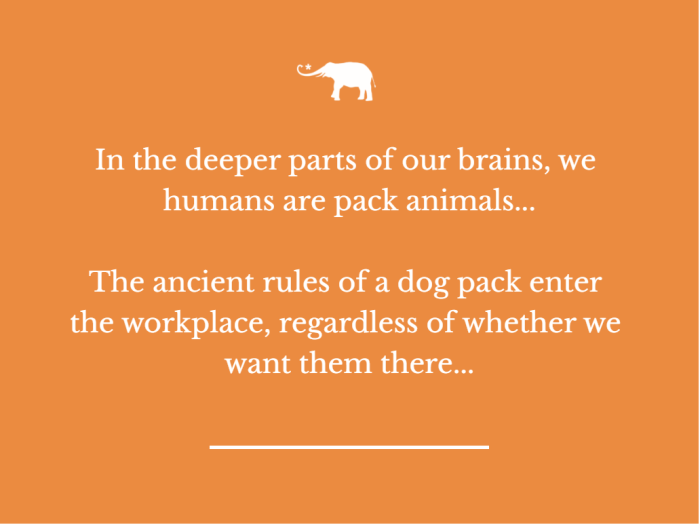Sometimes, we humans think we’re all that. Despite what our sense of species superiority would have us believe, our interpersonal dynamics are not far removed from those of a dog pack. In the deeper parts of our brains, we humans are pack animals, too, acting on survival instincts. Based on this little tidbit of neuroscience, current and aspiring organizational leaders are wise to reflect upon these four lessons from a dog pack.
Lesson #1. Contrary to popular opinion, alpha dogs become leaders as a consequence of what we now call soft skills, rather than through dominance or aggression. In fact, the alpha in a dog pack is consistently the most emotionally stable female. Packs tends to follow a leader who is tolerant, empathetic, and oriented to the greater good of the pack, rather than to their own position at its head. An aspiring alpha dog who is overly authoritarian, predominantly self-interested, or severely punitive loses pack respect and is denied its leadership role. In a pack, relationships are crucial to the alpha’s success.
Likewise, human leaders are most effective when they build authentic, inter-dependent relationships with other members of their pack, while maintaining healthy boundaries. The interpersonal connections leaders make with other pack members build the foundation of trust in their authority. We follow someone with whom we feel safe, and the pack’s willingness to follow is what makes the alpha their leader, not that individual’s job title. A perfect example of this pack dynamic lives in public schools, where the frequent pattern is that teachers and parents trust and respect the advice of the school secretary, more than the principal.
Lesson #2. Each member of the pack has a position in the hierarchy, but positions and their inter-relationships are fluid. If you think of the pack as a cluster of concentric circles, the alpha dog is at the center. The closer another dog is to that center, the higher its authority in the pack. Relationship proximity to the alpha brings significant benefits of transferred power. Those pack members with aspirations to lead are continually scrimmaging for a better position, nearer to the alpha at the center of power. Closer to the alpha, they are more secure in their pack membership.
Human packs behave similarly, with members jostling each other for relationship proximity to the perceived leader of their pack—who, remember, may not be the one with the Manager job title. Therefore, wise human leaders are circumspect about some of their actions that pull others closer: sharing inner-circle organizational information with other pack members or sharing their personal lives, for example. Knowledge is power, always, and intimate knowledge of a leader’s personal life or the organization’s vulnerabilities is a valuable currency of influence. Favoritism, singling out pack members for behind-the-scenes access and extra attention—especially extra-curricular attention—are powerful disrupters of pack cohesion. If a leader shares “private” information with one pack member, they also should know they are, potentially, telling every member, and feeding the faux intimacy of the gossip grapevine. Good alphas want their pack in authentic, productive relationships, not distracted by internal dramas. And all these “alpha’s pet” dynamics amplify the churn for pack position.
Lesson #3. There is always another pack member who wants to be the alpha. In other words, alphas wear a target on their backs that reads, “Come get me.” Yet, alphas rarely have to fight these Fido-come-lately challengers because their lieutenants step in to fight for them. The alpha assigns the task of holding their authority’s line in the sand, and that delegation allows the alpha to be a magnanimous follow-up to the fight. The alpha can observe the battle and then welcome a strong challenger to a new position in the pack, closer to the center. It’s a dynamic similar to bad cop—good cop in police interrogation, but bad dog—good dog.
Human leaders rarely emerge with a stronger leadership brand after the pack witnesses them going fang-to-fang with a pack member vying for power. A leader’s public defense of their authority never seems to end well for the leader’s reputation. A more productive pattern is for the leader to welcome and mentor aspiring leaders, while their lieutenants defend the power structure. The wisdom of this pack pattern is that one of those lieutenants is most likely to be the next alpha, and they benefit from the model of a mentor’s empathy and connection.
Lesson #4. Alphas are mostly subtle, rather than blatant. The alpha never barks when a low growl will get the message across; never dives for the jugular of a dog that has rolled onto its back in submission. Successful alphas hold the reins of power loosely. They stay above the daily fray of minor disagreements and squabbles. Alphas speak from their authority rarely, and only in moments critical to maintaining pack harmony. Human leaders with healthy emotional boundaries, the capacity for authentic expression without spectacle, and high emotional intelligence receive more respect than those who explode unpredictably, even if they later apologize.
Who we are at work is driven by who we are at our core, including the core of our brain. The ancient rules of a dog pack come into the workplace, regardless of whether we want them there, because these buried parts of every pack member’s brain hold our default, knee-jerk reactivity. Greater self-awareness and higher emotional intelligence enable leaders to work with these and similar predictable group dynamics, rather than doing daily battle with the inevitable snarling, snapping scrimmages of their pack.











Read 0 comments and reply